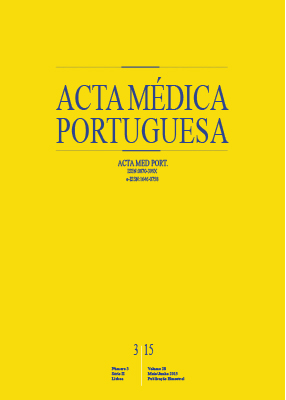Metallosis: A Rare Cause of Autoimmune Hemolytic Anemia
DOI:
https://doi.org/10.20344/amp.5766Keywords:
Anemia, Hemolytic, Autoimmune, Arthroplasty, Jaundice, Metals/adverse effects.Abstract
Introduction: Hemolytic anemia may be associated with multiple etiologies, including toxic substances, such as metals, which is a rare cause.Case Study: 55-year-old male, who underwent a total arthroplasty of the right hip (uncemented prostheses with ceramic-ceramic articulation with an acetabular component consisting of a dome composed of an alloy of titanium, aluminum and vanadium into which fitted a ceramic ‘insert’). Approximately 4 years after surgery the patient complained of noise originating from the prosthesis which occurred on movement. A surgical revision was performed and showed the presence of dark thick intracapsular fluid, fracture of the ceramic acetabular ‘insert’ and signs of wear of the acetabular metal dome. Extensive washing was carried out and the fractured ceramic ‘insert’ was replaced for a polyethylene ‘insert’. Two months later he was referred to the Emergency Room due to worsening of his general health, floating in the right hip and mucocutaneous jaundice. Laboratory tests suggested autoimmune hemolytic anemia. Arthrocentesis was performed and a large volume of metal fluid was drained off. The CT scan showed a large heterogeneous pelvic cystic collection seeded with prosthesis fragments, suggestive of metallosis. Hemolytic anemia was explained as toxicity of the particles and metal ions caused by the wear of the prosthesis. The patient was started on a high-dose steroid treatment. Afterwards, when he was stable, prosthesis components replacement and drainage of pelvic debris fluid were carried out.
Discussion: After the fracture of the ceramic ‘insert’ the ceramic head began to articulate directly with the metallic acetabular component, causing noise and wear with release of particles and ions. This caused a cystic pelvic abscess, which went unnoticed on the first surgical revision. Surgical debridement lead to the cystic collection extending into the adjacent tissues and the systemic circulation, triggering serious systemic effects, such as autoimmune hemolytic anemia. The potential toxicity of each of the metal elements of this prosthesis is unknown, and there are still no available laboratory tests for its detection.
Conclusion: Metallosis is a rare cause of autoimmune hemolytic anemia.
Downloads
Downloads
Published
How to Cite
Issue
Section
License
All the articles published in the AMP are open access and comply with the requirements of funding agencies or academic institutions. The AMP is governed by the terms of the Creative Commons ‘Attribution – Non-Commercial Use - (CC-BY-NC)’ license, regarding the use by third parties.
It is the author’s responsibility to obtain approval for the reproduction of figures, tables, etc. from other publications.
Upon acceptance of an article for publication, the authors will be asked to complete the ICMJE “Copyright Liability and Copyright Sharing Statement “(http://www.actamedicaportuguesa.com/info/AMP-NormasPublicacao.pdf) and the “Declaration of Potential Conflicts of Interest” (http:// www.icmje.org/conflicts-of-interest). An e-mail will be sent to the corresponding author to acknowledge receipt of the manuscript.
After publication, the authors are authorised to make their articles available in repositories of their institutions of origin, as long as they always mention where they were published and according to the Creative Commons license.









